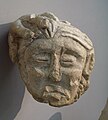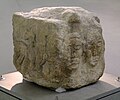Entremont (oppidum)
43°33′08″N 5°26′21″E / 43.552222°N 5.4391666°E

Entremont is a 3.5-hectare (8.6-acre) archaeological site three kilometres from Aix-en-Provence at the extreme south of the Puyricard plateau.[1] In antiquity, the oppidum at Entremont was the capital of the Celtic-Ligurian confederation of Salyes. It was settled between 180 and 170 B.C., somewhat later than the inhabitation of other oppida, such as Saint-Blaise (7th to 2nd centuries B.C.).[2][3][4] The site was abandoned when it was taken by the Romans in 123 B.C. and replaced by Aquae Sextiae (modern Aix-en-Provence), a new Roman city founded at the foot of the plateau.[5] By 90 B.C., the former oppidum was completely uninhabited.
The site contains two distinct areas of settlement surrounded by ramparts. Archaeologist Fernand Benoit named the older area, on the summit, "Ville Haute", and the lower "Ville Basse". Subsequently, it was recognised that the latter was an enlargement of the former, and they are now labelled "Habitat 1" and "Habitat 2", respectively.[6]
-
Habitat 1 (ville haute)
-
Habitat 2 (ville basse)
-
Fortification wall of Habitat 2 (ville basse)
-
"Portico of the Skulls"
Sculpture
[edit]Excavations at Entremont in the 1940s produced a large collection of fragmentary pre-Roman sculpture, most of which is now in the Musée Granet in Aix-en-Provence. The largest group of fragments consists of the heads and torsos of several male figures, usually interpreted as heroized warriors, depicted in a seated position with their legs folded beneath them and one hand resting on the severed head of an enemy. Heads and other pieces of a smaller number of female figures are also preserved, as are fragments of horses. Blocks from the architectural setting in which the figures were displayed are decorated with reliefs of additional severed heads and skull-shaped recesses, as well as horsemen and other figures. The sculptures were all carved from a fine-grained local limestone, and some of the fragments preserve traces of the original paint.[7]
-
Seated warrior
-
Head of a warrior
-
Torso of a warrior
-
Head of a woman
-
Severed heads
-
Severed head
-
Architectural block with severed heads and horseman
-
Relief of worshipers
See also
[edit]References
[edit]- ^ Histoire d'une ville. Aix-en-Provence, Scéren, CRDP de l'académie d'Aix-Marseille, Marseille, 2008, p. 20-25.
- ^ Patrice Arcelin, « Avant Aquae Sextiae, l'oppidum d'Entremont » in Carte archéologique de la Gaule : Aix-en-Provence, pays d'Aix, val de Durance, 13/4, Fl. Mocci, N. Nin (dir.), Paris, 2006, Académie des inscriptions et belles-lettres, ministère de l'Éducation nationale, ministère de la Recherche, ministère de la Culture et de la Communication, maison des Sciences de l'homme, centre Camille-Jullian, ville d'Aix-en-Provence, communauté du pays d'Aix, p. 125.
- ^ Voyage en Massalie. 100 ans d'archéologie en Gaule du Sud, Musées de Marseille/Édisud, Marseille-Aix-en-Provence, 1990, p. 251.
- ^ Historiquement, le début de peuplement du plateau d'Entremont correspond à la période d'abandon des oppida de Teste-Nègre (Les Pennes-Mirabeau) et de Notre-Dame-de-Pitié (Marignane).
- ^ « Histoire d'Aix » Archived 2013-11-04 at the Wayback Machine, site de l'office du tourisme d'Aix-en-Provence.
- ^ Voyage en Massalie..., op. cit., p. 102.
- ^ F. Benoit, "The Celtic oppidum of Entremont, Provence", in R. Bruce Mitford, ed., Recent Archaeological Excavations in Europe (London 1975), pp. 227–259, at 250–258.













